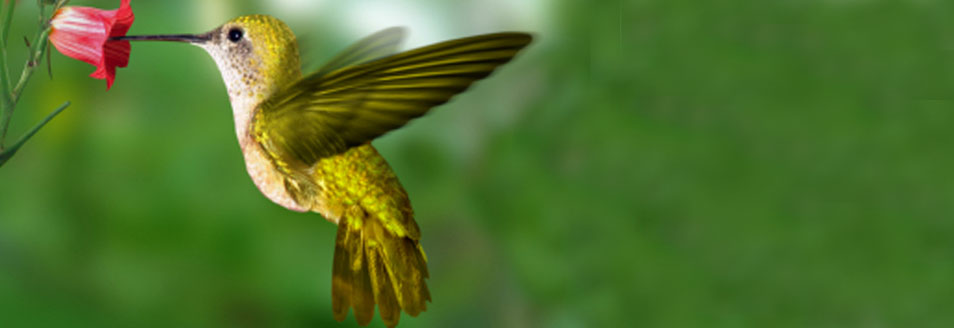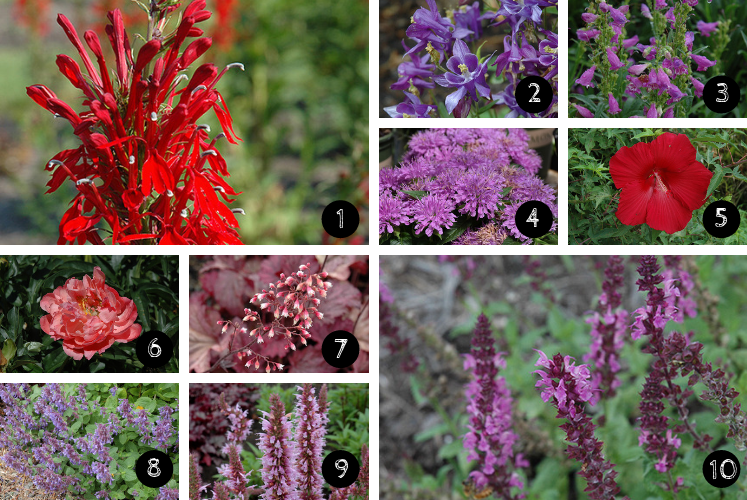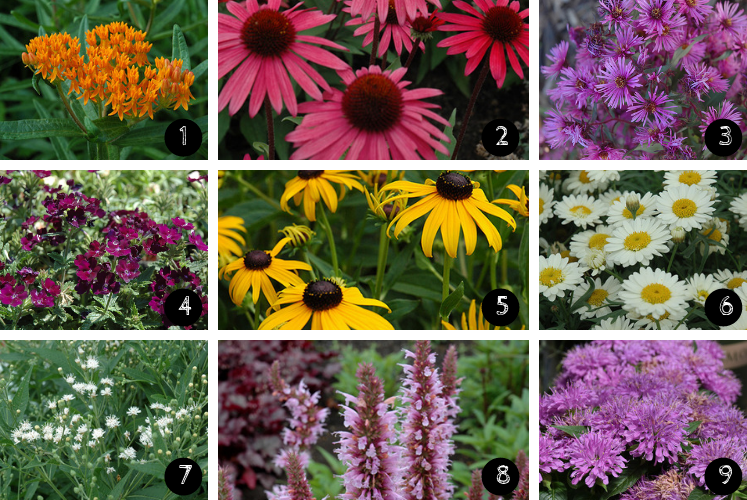Hummingbirds, Butterflies, and Bees: Attracting Pollinators to Your Garden

You may love hummingbirds, butterflies, and bees for the buzz of activity and burst of color they add to your yard. But these pollinators also do a lot of good for the environment. Learning how to attract pollinators to your garden is easy when you know the right plants to choose and how to create an inviting oasis.
Skip Ahead:
- What Are Pollinators?
- Gardening to Attract Hummingbirds, Butterflies, and Bees
- Flowers that Attract Pollinators
What Are Pollinators?
Bees, hummingbirds, and butterflies are members of a group called pollinators that play a vital role in plant reproduction. Beetles, dragonflies, moths, bats, birds, and some small mammals are also classified as pollinators.
Pollinators carry pollen on their bodies as they travel between plants. When they land on plants to drink nectar or feed on pollen, pollen grains attach to their body and are transferred as they visit other plants. Pollen carries genetic materials needed for the reproduction of flowering plants, including many fruits and vegetables.

According to the Pollinator Partnership, up to 95% of flowering plants need help in the pollination process. In fact, one out of every three bites of food that you eat is available to you because of pollinators. In addition to aiding in the food cycle, pollinators also clean our air, stabilize soils, protect us from extreme weather, and support other wildlife.
Bees are the most well-known pollinators and they pollinate apple, alfalfa, strawberry, and blueberry crops. Hummingbirds are nectar-loving pollinators that aid in the pollination of honeysuckle and bee balm. Butterflies are less efficient pollinators because their entire body doesn’t get coated with pollen, but they still help pollinate many species of wildflowers and are especially attracted to milkweed.
Gardening to Attract Hummingbirds, Butterflies, and Bees
Unfortunately, many pollinator populations are on the decline. This is due to a number of factors including loss of feeding and nesting areas, pollution, chemicals, disease, and changes in the climate. However, in many cases, suburbs – including your own backyard – have been shown to have more diverse pollinator communities.

Creating a pollinator garden that includes the necessary elements for attracting hummingbirds, butterflies, and bees will ensure that they can continue to perform their essential work. Here’s how to help pollinators thrive:
- Native plants are the way to go! Pollinators that are local to your area have long fed on plants that are local to the area. When you grow native plants in your garden, not only will these plants grow successfully in your local soil and climate, but they’re also giving pollinators consistent access to the food they need to thrive. Non-native plants may not provide the same results.
- Avoid hybrid plants. Hybrid flowers may provide a spectacular bloom, but often they don’t provide the pollen and nectar necessary to support pollinators in all life stages.
- Think year-round blooming. Planting a variety of spring- and fall-blooming plants is necessary for attracting pollinators to your garden year-round. Also choose plants that offer a variety of different colors, fragrances, and heights.
- Provide food and water sources. In addition to the plants you choose to attract pollinators, you should also add other food and water sources in your garden. For hummingbirds, this includes a nectar feeder. Although many homeowners lament the fact that bees also feed on the nectar in their feeders — it can be a good thing! A birdbath or fountain will provide ample water for garden visitors.
- Plant in big batches. When you plant big batches of the same plants it makes it easier for pollinators to forage. When they visit the same type of plant, again and again, they don’t have to “relearn” how to enter plants to feed. Big areas of the same plants make pollen transfer between accepting plants more efficient.
- Provide areas of shelter. As much as you may want a pristine garden, leaving some debris provides your pollinators with nesting areas. These can include areas of bare ground, dead wood, or leaf litter. This is especially important from late fall to early spring, when natural nesting areas may be scarce.
Flowers That Attract Pollinators
So how can you be sure that the plants and shrubs you choose will bring pollinators your garden? With so many plants to choose from, it can seem overwhelming. Let us help! Here are just a few native plants that attract hummingbirds, butterflies, and bees.
Plants That Attract Hummingbirds
Hummingbirds are attracted to red and orange plants, although odor is not important. Their long beaks allow them to feed on funnel-shaped flowers. They also prefer a strong perch when feeding.

- Cardinal Flower (Lobelia)
- Columbine (Aquilegia)
- Penstemon
- Bee Balm (Monarda)
- Hibiscus (Tropical and Hardy)
- Peony
- Coral Bells (Heuchera)
- Catmint (Nepeta)
- Agastache
- Salvia (Annual and Perennial)
Plants that Attract Butterflies
Butterflies are drawn to brightly colored plants, including reds and purples. They prefer fresh scents that are faint, not overwhelming. They feed best on plants with narrow, tube-like flowers with a wide landing pad.

- Butterfly Weed (Asclepias)
- Coneflower (Echinacea)
- Aster
- Verbena
- Black Eyed Susan (Rudbeckia)
- Daisy (Leucanthemum)
- Ironweed (Veronia)
- Agastache
- Bee Balm (Monarda)
Plants that Attract Bees
Bees prefer bright white, yellow, or blue plants with a fresh, mild odor. They can feed easily on plants with shallow, tubular flowers and a landing platform.

- Butterfly Weed (Asclepias)
- Coneflower (Echinacea)
- Aster
- Salvia (annual and perennial)
- Black Eyed Susan (Rudbeckia)
- Daisy (Leucanthemum)
- Ironweed (Veronia)
- Agastache
- Bee Balm (Monarda)
If you’re eager to attract hummingbirds, butterflies, and other pollinators to your garden, talk to the experts in our garden centers for even more advice. Or shop online.
